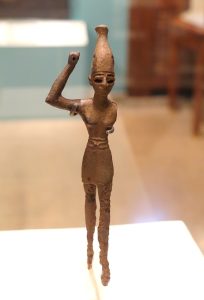By the time Moses arrived on the scene, around 1500 BC, the Hebrews had been in Egypt for at least a century, and possibly as long as three hundred years. The days of Joseph serving as vizier to the pharaoh were long gone. The Hebrews had grown from an extended family of about six dozen to a couple million, but they were suffering under the rule of a nation that no longer valued their presence except as forced labor.

So Yahweh set the next phase of His plan in motion. After guiding the life of Moses from infancy to adulthood (you don’t think he survived that trip in the reed boat by accident, do you?), Yahweh appeared to Moses in his exile and tasked him with bringing Israel out of Egypt. And the way God had him do it was a clear message to the gods of Egypt.
Moses’ first encounter with Yahweh was in Midian. That was at Horeb in the northern Sinai, later part of Edom (contrary to long tradition that puts the mountain in southern Sinai), the har elohim, or mountain of God. Get this: The burning bush incident was the first time since Eden that a human had come face to face with Yahweh on His holy mountain. There is no question that the bene elohim, the Fallen “sons of God,” the seventy rebel angels God allotted to the nations after Babel, knew about this meeting. It was a very clear message from Yahweh to the rebels: I have reestablished my mount of assembly on the earth.
The time had finally come. God called Moses back to Egypt to bring His people, Israel, to the place He’d claimed as His own—Canaan.
Yahweh chose to convince pharaoh and the Egyptians to not only let Israel leave, but to encourage them to go. He did it by hardening pharaoh’s heart through a series of increasingly severe trials until the people of Egypt must have been begging pharaoh to let His people go.
There are several studies you can find online that draw links between the ten plagues Yahweh inflicted on Egypt and specific Egyptian gods. For example, the first plague turned the Nile River to blood. This is said to have been directed at Hapi, the god of the annual Nile flood. Plague number two, frogs, was aimed at Heqet, a fertility goddess worshipped since the early dynastic period—the time of Narmer and the first kings of Egypt, about 1,500 or 1,600 years before Moses.
Those match up well enough, but when we get to the third and fourth plagues, the connections are iffy at best. The plague of lice or gnats, depending on the translation you read, doesn’t match up well with any known Egyptian god. The plague of flies is paired by some with Khepri, a god of creation. But Khepri had a scarab beetle for a head, so that’s not a good match, either.
Some of the pastors and teachers who’ve published these studies are very intelligent people whom I respect. However, and with all due respect to those pastor-teachers, they’ve overlooked an even bigger supernatural conflict, and understanding that confrontation will show you why trying to link the ten plagues to specific Egyptian gods is looking in the wrong direction.
More accurately, it’s looking at the wrong pantheon.
Yes, Yahweh demonstrated with the ten plagues that His power was superior to that of the gods the Egyptians trusted to keep the Nile flowing and the crops growing. And we know for a fact that Yahweh put a hurt on the gods of Egypt the night He took the lives of Egypt’s first-born.
How do we know? He told Moses.
For I will pass through the land of Egypt that night, and I will strike all the firstborn in the land of Egypt, both man and beast; and on all the gods of Egypt I will execute judgments: I am the LORD.
Exodus 12:12 (ESV), emphasis added
How likely is it that Yahweh told Moses that He was about to punish imaginary beings? What would be the point? How would that demonstrate His power and glory?
No, something happened in the spirit realm on the night of the Passover. When Yahweh passed through the land of Egypt, taking the lives of firstborn humans and animals, He simultaneously carried out His sentence on the bene elohim, the entities who’d rebelled and made themselves gods in Egypt.
Here’s a fascinating detail we never hear about in church: It appears there was a very old tradition in Egypt, an ancient myth dating back centuries before the Exodus, that a day was coming when the first-born of Egypt would die. The pyramids of the 5th Dynasty king Unas, c. 2350 BC, and the 6th Dynasty king Teti, c. 2320 BC, are inscribed with this line from a well-known inscription called the “Cannibal Hymn”:
It is the king who will be judged with Him-whose-name-is-hidden on this day of the slaying of the first-born.[1]
Similar phrases are found on other coffins from Egypt’s Middle Kingdom, including a variant that reads “this night of the slaying of the first-born.” Some scholars believe the context of the Coffin Texts and the Cannibal Hymn points to the first-born belonging to the gods, although that’s not a view shared by all Egyptologists.
What does it mean? Scholars aren’t sure. But it seems that by the time of the Exodus, there was a very old tradition in Egypt of a future nightmare event when the first-born would be killed.
Consider this possibility: Maybe the Coffin Texts and the “Cannibal Hymn” were an ancient warning to Egypt of that coming day of judgment. And forty years earlier on Mount Sinai, Yahweh revealed to Moses that He was Him-whose-name-is-hidden, I AM WHO I AM—the One who would fulfill the prophecy of the slaying of the first-born.
That’s speculation, of course, but fascinating. And we’re not at the best part yet.
Scholars today, 3,500 years later, still argue about where the Red Sea crossing occurred. We won’t get into it here. If it hasn’t been settled by now, we’re not going to put the question to bed in a couple of paragraphs. What matters is what Yahweh told Moses to do next.
Then the Lord said to Moses,
“Tell the people of Israel to turn back and encamp in front of Pi-hahiroth, between Migdol and the sea, in front of Baal-zephon; you shall encamp facing it, by the sea.
Exodus 14:1–2 (ESV), emphasis added
Okay, this begs some questions: Why did God tell Moses to turn back? Why did He command Moses to camp facing Baal-zephon? What is Baal-zephon? And mostly, what was Baal doing in Egypt?
You know Baal was the Canaanite storm-god and the king of their pantheon. He’s mentioned in the Bible from the Book of Exodus through the gospels. Baal, which is properly pronounced bah-awl with a glottal stop like, “Uh-oh,” was the main thorn in the side of the followers of Yahweh for about the next 1,500 years, all the way down to the time of Jesus.
But during the Second Intermediate Period in Egypt, roughly 1750 to 1550 BC (give or take a hundred years), foreigners from Canaan called the Hyksos ruled northern Egypt. Their capital was at Avaris in the Nile delta, and they worshipped the gods of the Canaanite pantheon, which was headed by Baal.
Why is that relevant? Stay tuned. We’ll get to that next time.
[1] Rendsburg, Dr. Gary. “YHWH’s War Against the Egyptian Sun-God Ra: Reading the Plagues of Locust, Darkness, and Firstborn in their Ancient Egyptian Context,” TheTorah.com (http://thetorah.com/yhwhs-war-against-the-egyptian-sun-god-ra/), retrieved 12/24/16.

